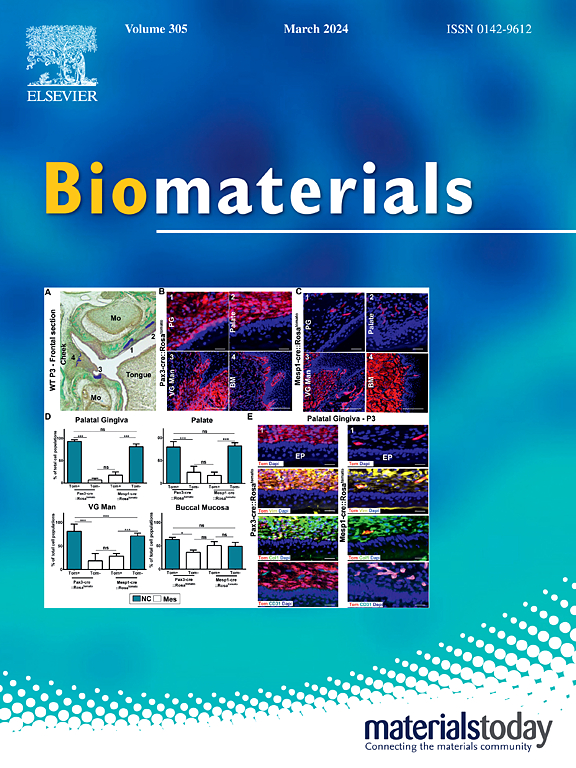A controllable self-amplifying oxidative stress strategy for boosting noninvasive sonodynamic therapy and synergistic immunotherapy
IF 12.9
1区 医学
Q1 ENGINEERING, BIOMEDICAL
引用次数: 0
Abstract
The combined application of sonodynamic therapy (SDT) and immune checkpoint blockade may be hindered by the antioxidant defense mechanisms of tumor cells and the immunosuppressive tumor microenvironment (TME). SDT may be enhanced through nanotechnology to improve sonosensitizer delivery and drug release triggered by reactive oxygen species (ROS). However, strategies to amplify ROS cascades and synergize with immune checkpoint blockade remain underexplored. In this study, a pH/ROS dual-responsive nanoplatform (designated as FHPCL NPs) that targets tumor tissues with a “self-amplifying oxidative stress” strategy to synergistically enhance the efficacy of SDT and immunotherapy was developed. This nanoplatform established a “drug release-ROS generation-carrier disintegration” positive feedback loop in the tumor tissues when combined with ultrasound technology, thereby inducing massive ROS production. In a 4T1 breast cancer model, this strategy achieved an in situ tumor suppression rate exceeding 80 %. Importantly, the integrated platform significantly promotes dendritic cell maturation and cytotoxic T lymphocytes infiltration by inducing immunogenic cell death, thereby activating enhanced immune responses and systemic immunological effects. Furthermore, we demonstrated that combining FHPCL NPs-augmented SDT with anti-programmed death ligand 1 markedly inhibited tumor growth and pulmonary metastasis, and established durable immune memory. This study provides a promising strategy for tumor therapy.

一种促进无创声动力治疗和协同免疫治疗的可控自我放大氧化应激策略
超声动力疗法(SDT)和免疫检查点阻断联合应用可能受到肿瘤细胞抗氧化防御机制和免疫抑制肿瘤微环境(TME)的阻碍。可以通过纳米技术增强SDT,以改善由活性氧(ROS)触发的声敏剂递送和药物释放。然而,扩大ROS级联和与免疫检查点阻断协同的策略仍未得到充分探索。在本研究中,开发了一种pH/ROS双响应纳米平台(称为FHPCL NPs),该平台通过“自我放大氧化应激”策略靶向肿瘤组织,协同增强SDT和免疫治疗的疗效。该纳米平台与超声技术结合,在肿瘤组织中建立了“药物释放-ROS生成-载体分解”的正反馈回路,从而诱导大量ROS的产生。在4T1乳腺癌模型中,该策略实现了超过80%的原位肿瘤抑制率。重要的是,该集成平台通过诱导免疫原性细胞死亡,显著促进树突状细胞成熟和细胞毒性T淋巴细胞浸润,从而激活增强的免疫应答和全身免疫效应。此外,我们证明FHPCL nps增强的SDT与抗程序性死亡配体1结合可显著抑制肿瘤生长和肺转移,并建立持久的免疫记忆。这项研究为肿瘤治疗提供了一个有希望的策略。
本文章由计算机程序翻译,如有差异,请以英文原文为准。
求助全文
约1分钟内获得全文
求助全文
来源期刊

Biomaterials
工程技术-材料科学:生物材料
CiteScore
26.00
自引率
2.90%
发文量
565
审稿时长
46 days
期刊介绍:
Biomaterials is an international journal covering the science and clinical application of biomaterials. A biomaterial is now defined as a substance that has been engineered to take a form which, alone or as part of a complex system, is used to direct, by control of interactions with components of living systems, the course of any therapeutic or diagnostic procedure. It is the aim of the journal to provide a peer-reviewed forum for the publication of original papers and authoritative review and opinion papers dealing with the most important issues facing the use of biomaterials in clinical practice. The scope of the journal covers the wide range of physical, biological and chemical sciences that underpin the design of biomaterials and the clinical disciplines in which they are used. These sciences include polymer synthesis and characterization, drug and gene vector design, the biology of the host response, immunology and toxicology and self assembly at the nanoscale. Clinical applications include the therapies of medical technology and regenerative medicine in all clinical disciplines, and diagnostic systems that reply on innovative contrast and sensing agents. The journal is relevant to areas such as cancer diagnosis and therapy, implantable devices, drug delivery systems, gene vectors, bionanotechnology and tissue engineering.
 求助内容:
求助内容: 应助结果提醒方式:
应助结果提醒方式:


